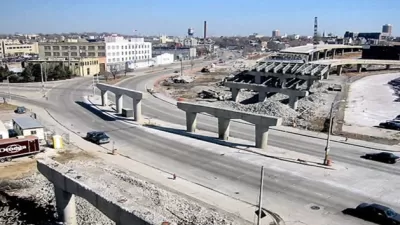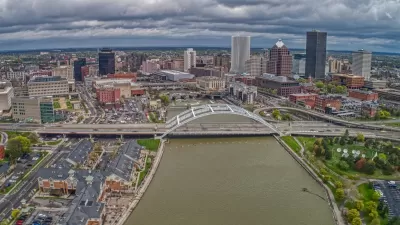Alana Semuels, staff writer for The Atlantic, examines highway teardowns beginning with the San Francisco Embarcadero in 1989 to see how they have worked in terms of revitalizing poorer areas or restoring the urban fabric that they destroyed.

"As some of the highways reach the end of their useful life, cities and counties are debating the idea of tearing down urban freeways and replacing them with boulevards, streets, and new neighborhoods," writes Semuels.
Semuels writes on the findings of a study, "Urban Interstate Rights-of-Way as Sites of Intervention" released last year by Ted Shelton and Amanda Gann of the University of Tennessee.
“The removal of urban interstates is a growing trend in the U.S,” write Shelton and Gann. "This trend, if carried to its logical extreme, can yield sites of intervention that hold the promise of remaking the American city."
“Where urban highway construction did occur, in urban design terms, it was highly detrimental to the urban fabric; creating physical and psychological rifts that are extremely difficult to bridge and introducing a substantial source of noise and air pollution [...] Cities across the country continue to struggle with this legacy.”
Milwaukee's removal of Park East freeway in 1999 yielded important lessons for cities considering similar teardowns.
"(U)rban development has blossomed in the neighborhoods created by the highway’s removal. Manpower Corporation moved its headquarters to the area, and the average assessed land value there grew 45 percent.
It’s an important lesson for some of the nation’s most economically depressed cities, which are considering urban freeway removal projects as a means of economic development.
Semuels points to New Haven, Conn., "in the midst of a project called Downtown Crossing, which has removed parts of Route 34 and is putting up new buildings in an area of town bisected by the freeway," and ends with Syracuse, N.Y., debating a teardown of I-81 which "bisected the city when it was completed in the 1960s."
Suburban residents and business owners want to see the elevated portions of the highway expanded or rebuilt. New Urbanists want the highway torn down and a boulevard constructed in a way that could encourage the development of pedestrian-friendly businesses and parks.
A short summary of they teardowns was posted as a Planetizen exclusive in 2007 by Charles Siegel and an updated edition here.
FULL STORY: Highways Destroyed America's Cities

Study: Maui’s Plan to Convert Vacation Rentals to Long-Term Housing Could Cause Nearly $1 Billion Economic Loss
The plan would reduce visitor accommodation by 25,% resulting in 1,900 jobs lost.

North Texas Transit Leaders Tout Benefits of TOD for Growing Region
At a summit focused on transit-oriented development, policymakers discussed how North Texas’ expanded light rail system can serve as a tool for economic growth.

Why Should We Subsidize Public Transportation?
Many public transit agencies face financial stress due to rising costs, declining fare revenue, and declining subsidies. Transit advocates must provide a strong business case for increasing public transit funding.

How to Make US Trains Faster
Changes to boarding platforms and a switch to electric trains could improve U.S. passenger rail service without the added cost of high-speed rail.

Columbia’s Revitalized ‘Loop’ Is a Hub for Local Entrepreneurs
A focus on small businesses is helping a commercial corridor in Columbia, Missouri thrive.

Invasive Insect Threatens Minnesota’s Ash Forests
The Emerald Ash Borer is a rapidly spreading invasive pest threatening Minnesota’s ash trees, and homeowners are encouraged to plant diverse replacement species, avoid moving ash firewood, and monitor for signs of infestation.
Urban Design for Planners 1: Software Tools
This six-course series explores essential urban design concepts using open source software and equips planners with the tools they need to participate fully in the urban design process.
Planning for Universal Design
Learn the tools for implementing Universal Design in planning regulations.
Ascent Environmental
Borough of Carlisle
Institute for Housing and Urban Development Studies (IHS)
City of Grandview
Harvard GSD Executive Education
Toledo-Lucas County Plan Commissions
Salt Lake City
NYU Wagner Graduate School of Public Service





























